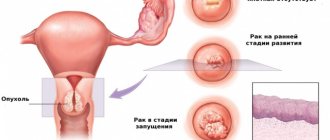Cause of uterine cancer
As a rule, in young women, uterine cancer develops against the background of hyperplasia (excessive enlargement) of the mucous membrane.
In women 50-60 years old, cancer of the uterine mucosa appears against the background of atrophy (reduction) of the endometrium. This type of oncology has a disappointing prognosis. According to international studies, it was found that uterine cancer is directly related to a woman’s hormonal levels. Most often, patients have high levels of estrogen in the blood, which can serve as an impetus for the development of a malignant tumor.
It is important to note that there are risk factors that may be involved in the occurrence of endometrial cancer, namely:
- menopause (late);
- regular menstrual irregularities;
- lack of ovulation and inability to conceive a child (and if pregnancy occurs, miscarriage);
- high doses of estrogen (taking medications).
Main symptoms of endometrial cancer
Symptoms can vary from woman to woman, and many gynecologic cancers, including endometrial, ovarian, and cervical cancers, share some of the same symptoms. If a woman has gone through menopause, it is especially important to report any unusual signs and symptoms.
The most common symptoms of endometrial cancer are:
- Vaginal postmenopausal bleeding.
- Premenopausal or perimenopausal bleeding: bleeding, heavy periods, or bleeding between menstrual periods. Women with endometrial cancer are likely to experience any abnormal vaginal bleeding.
- Abnormal vaginal discharge.
- Pelvic pain or pressure, usually occurring in the later stages of the disease.
- Weight loss.
Most of these symptoms do not mean that the woman has cancer. But, if she notices one or more symptoms for more than two weeks, she needs to see a doctor. When to start looking for cancer?
Rate
—
What does the process of developing uterine cancer look like?
It is not completely clear why the tumor occurs. But there are certain conditions that often accompany uterine cancer. These are precancerous pathologies.
Usually everything begins gradually and in certain stages. This is what the process looks like:
- First, there is an excessive growth of the mucous layer of the uterus or its reduction.
- Further, for some possible reasons, dysplasia appears. This is when the cells of the mucous membrane change or other cells begin to appear in their place that should not be there. For example, epithelial cells from the cervical canal.
- The next stage will be a failure in the process of regulating cell reproduction and restoration. A certain structure called the basement membrane is responsible for this. Violation of this structure means that cells begin to multiply uncontrollably. It is from this moment that a benign tumor appears.
- The benign tumor continues to grow. It repeats the cells from which it grows. Its size is slowly increasing. She may not show herself at all. And at some stage there is a transition to a malignant process.
But it may be that there is no period of formation of a benign process. That is, from a precancerous condition a malignant tumor immediately appears.
During a malignant process, the cells will be atypical, that is, modified in structure, shape and size. They begin to divide very quickly and continuously. And at some point there is a separation from their main location. Through the bloodstream, malignant cells spread throughout the body, affecting other organs. This is called metastasis.
Reasons for development
Carcinoma or cervical cancer can be triggered by exposure to the following factors on the human body:
- hormonal imbalance;
- frequent stress;
- overwork;
- bad habits;
- poor nutrition;
- absence of childbirth;
- previous abortions;
- surgical interventions;
- infection with human papillomavirus;
- obesity;
- presence of sexually transmitted infections;
- diabetes;
- hypertonic disease;
- HIV status;
- taking tablet contraceptives;
- erosions and ulcers on the genitals;
- leukoplakia;
- hereditary predisposition.
Cervical erosion, under the influence of various factors, can be a precursor to oncology.
All these factors can provoke a pathological mutation of cells, as a result of which they begin to divide uncontrollably and are no longer able to perform their functions. The development of In Situ cancer or a malignant process that does not extend beyond the outer mucous membrane is often preceded by specific diseases such as erosions, ulcers or papillomas. Lobular carcinoma is the result of the growth of atypical cells deep into the organ.
Types of uterine cancer
In medical practice, there are 7 forms of this malignant disease. Cancer is a sign of a malignant process. And its type depends on the cells from which the tumor was formed.
- Adenocarcinoma of the uterus. The tumor is formed from cells that produce mucus in the uterus. The upper part of the uterus is most often affected, since there are most of them there.
- Clear cell adenocarcinoma. A rare form of cancer with a fairly aggressive course and a high probability of early metastasis. Occurs more often in older people. Grows from light cells of the mucous layer.
- Squamous form. This form is one of the most common in middle-aged women. Instead of a mucous layer, skin epithelium appears in a certain area. At the site of the lesion, the mucous membrane loses its elasticity and becomes rough to the touch.
- Serous uterine cancer. An aggressive and rare type of cancer where pathological epithelium is formed. Most often, the ovaries are also affected along with the uterus.
- Glandular squamous cell carcinoma of the uterus is a mixed form of malignant tumor, which combines elements of adenocarcinoma and squamous cell carcinoma.
- Mucinous form. This type of cancer is often called mucous cancer. This is due to the fact that cancer cells produce their own mucus.
- Undifferentiated form. The tumor grows quite quickly in the uterine mucosa and often metastasizes. This type of cancer is quite difficult to treat and has a poor prognosis.
Classification
Uterine malignancies are classified in a variety of ways, and each approach has clinical and prognostic implications.
Types of uterine cancer by histological structure. There are more than 10 possible forms, but the most common of them (up to 80%) is endometrial adenocarcinoma. It can be low (G3), medium (G2) and highly differentiated (G1). Differentiation is the process of cell maturation after division. The more differentiated the tumor, the less aggressive its development and, therefore, the better the prognosis.
By growth pattern:
- exophytic - forms a focus in the organ cavity;
- endophytic – grows into the walls of the uterus;
- mixed.
The prevalence of a neoplasm, like any other cancer, is described in the TNM system. This approach implies:
- determination of the size of the main tumor node and germination into surrounding tissues;
- damage to regional lymph nodes - those into which lymph flows from the uterus;
- assessment of distant metastases.
Stages of uterine cancer
The course and favorable outcome of the disease directly depend on the stage of cancer development. There are 4 of them in total:
- The first stage - the neoplasm is located in the body of the uterus, affecting the mucous layer and myometrium (uterine muscles) by 50%.
- The second stage - the neoplasm spreads to the entire uterus and enters the cervical canal. But the tumor has not yet spread beyond the uterus.
- The third stage - the neoplasm spreads to neighboring pelvic organs. That is, the vagina, accessory organs (ovaries, fallopian tubes), surrounding tissues and pelvic lymph nodes are affected.
- Stage four - the malignant process spreads to the bladder and lower intestine. At this stage, metastases are detected in various organs (liver, lungs).
- This division into stages is one of the main things in the diagnosis. It is necessary not only to assess the activity of the malignant process, but also to select appropriate treatment tactics. Each stage has its own treatment.
TNM stages
First. The tumor is limited to the organ:
- a. germination of no more than 50% of the thickness of the muscle layer;
- b. germination of more than half the thickness of the muscle layer.
Second. The carcinoma has grown into the cervix, but still does not extend beyond the walls of the uterus.
Third. The neoplasm begins to spread beyond the organ:
- a. germination of the serous (outer) membrane of the uterus, tubes, ovaries;
- b. invasion of the vagina or parametrium;
- c. damage to regional lymph nodes.
Fourth stage. Distant metastases are determined (lungs, liver, bones, inguinal lymph nodes).
Possible symptoms of uterine cancer
As a rule, there will be no manifestations of cancer in the initial stages. This disease can develop unnoticed for many years. Cancer can have such a latent course that symptoms may only appear at stages 3-4.
Since women have a very sensitive menstrual cycle, it will react to the slightest changes in the body. Therefore, cycle disturbances can occur even in the early stages. You should definitely pay attention to:
- scanty, spotting or heavy menstrual discharge from the genital tract;
- pulling or aching pain in the lower abdomen, which bothers not only during menstruation;
- copious mucous discharge from the genital tract (especially with mucinous cancer).
This is the only way a tumor can manifest itself in the first stages. When a tumor grows and, even more so, affects surrounding tissues, organs and metastasizes, then the symptoms can be very different. But there are certain signs that may indicate uterine cancer:
- Dull pain that can be constant or variable. The reason is compression of the nerve endings.
- Enlarged inguinal lymph nodes. They do not hurt and are fused with the skin. The reason is the spread of cancer cells to local lymph nodes.
- Problems with urination. Due to the spread of the tumor to the urethra and bladder.
- Possible constipation. Damage to the rectum and intestinal loops by squeezing them.
- Weakness and general malaise. They occur in advanced cases and are associated due to constant intoxication of waste products of the tumor.
Diagnosis of uterine cancer
In the early stages, it is quite difficult to detect the disease. This is due to the absence of any signs and the relatively small size of the tumor.
The main goal in making a diagnosis will be to determine the type of tumor, its size, stage, condition of the lymph nodes and the presence of local or distant metastases.
Usually, suspicion of uterine cancer arises during a gynecological examination or ultrasound. In the first option, the uterus is slightly enlarged, and areas of altered tissue may be observed. The appendages may also be enlarged. An ultrasound can show the tumor itself, its contours, size and location. Ultrasound is also used to assess the condition of local lymph nodes.
Next, you need to confirm what kind of tumor it is and whether it is malignant. The genital tract is examined using a hysteroscope. This is a special tubular instrument with an optical system, which makes it possible to visually evaluate the mucous membrane of the cervical canal, the uterine cavity and accurately detect a tumor.
Next, a tumor biopsy is performed, a piece of tissue is taken for histological and cytological examination. This is the most important stage of diagnosis. It is necessary to determine:
- malignant process (or excluding it),
- types of tumor (from which cells the tumor grows),
- stage of the disease.
If there are signs of the last stages, then a comprehensive assessment of the chest, pelvic and abdominal organs is carried out to identify metastases. And then the appropriate treatment tactics are prescribed.
Forecast
Life expectancy depends on the stage of tumor growth. Five-year survival rates for patients range from 86% in early stages to 5.3% in late stages.
Factors that worsen the prognosis:
- age over 60 years;
- low differentiation (G3) of tumor cells;
- germination to a depth of more than half of the myometrium (muscle layer);
- transition of the tumor to the isthmus or neck;
- metastasis to lymph nodes and ovaries;
- spread to the peritoneum;
- low number of receptors for female sex hormones in carcinoma tissues;
- the appearance of tumor emboli in vessels, both blood and lymphatic.
According to the World Association of Oncologists, the 5-year survival prognosis for uterine cancer is 67.7%.
Treatment of uterine cancer
Treatment for uterine cancer is prescribed based on:
- stage of the disease,
- the size of the malignant neoplasm,
- accompanying pathologies,
- patient's age,
- types of tumor
- presence of metastases.
There are 4 methods of therapy: hormonal, chemotherapy, radiation and classical surgery. Typically, uterine cancer, and most other tumors, are treated using several methods in stages. This gives a better effect and a greater chance of recovery.
So, removal of uterine cancer:
- At stage 1, the mucous layer and half of the myometrium are scraped out, since these are the layers that are affected at this stage. Afterwards, hormonal drugs are prescribed to normalize the menstrual cycle and restore the endometrium.
- At stage 2, the uterus is completely removed. Often an extended operation is performed with resection of the fallopian tubes and ovaries. This is due to the frequent spread of the tumor to these structures. At the same time, irradiation of the pelvic area is used.
- Stage 3 involves additional surgical removal of the cervix and part of the vagina. Local lymph nodes are removed. In addition to radiation therapy, chemotherapy with antitumor drugs is used. They inhibit the proliferation of cancer cells. But also our own.
- At stage 4 cancer, it is impossible to completely remove the tumor. Therefore, they try to eliminate as much tissue affected by malignant cells as possible. Chemotherapy and radiation are used. All these measures are prescribed to alleviate the patient’s general condition, since stage 4 cannot be cured.
Prognosis of uterine cancer
The earlier a malignancy is detected, the more favorable the prognosis. It all depends on the structure of the cancer, as well as the stage and extent of damage to the patient’s organs. Accordingly, the forecast for:
- Stage 1 uterine cancer is the most favorable. Surgery and properly selected therapy allow the patient to completely get rid of the formation.
- Stage 2, the patient will need a fairly long recovery time (up to 3 years). With surgical intervention, complete loss of reproductive function is possible, and the patient also experiences a serious hormonal disorder. In general, the prognosis is favorable with complex treatment.
- At stage 3 of uterine cancer, metastases begin to grow in the vagina. Quite intensive treatment is prescribed - chemotherapy, radiation therapy, immunotherapy. The prognosis is not always favorable. The five-year survival rate is about 30-40%.
- For stage 4 the prognosis is unfavorable. Quite often, the fight against a malignant tumor and metastases ends in death. All treatment is aimed at relieving symptoms.
Prevention of uterine cancer
The best method of prevention is early detection. And for this you need to be completely examined in the hospital once a year. And do not delay visiting a specialist if you detect any suspicious symptoms.
When remission is achieved, every woman should monitor her health, undergo regular examinations and tests. All this must be done in order not to miss a possible recurrence of uterine cancer. Recurrence may occur after a couple of years, decades, or not appear at all after treatment. Unfortunately, medicine cannot accurately determine this.
For women who have had uterine cancer, it is important to adhere to a healthy lifestyle, adjust their daily routine, rest, and improve their diet. If possible, try not to experience unnecessary stress. They greatly harm the body. This will allow you to gain strength and improve the functioning of all organs.
Attention!
This article is posted for informational purposes only and under no circumstances constitutes scientific material or medical advice and should not serve as a substitute for an in-person consultation with a professional physician.
For diagnostics, diagnosis and treatment, contact qualified doctors! Number of reads: Date of publication: 04/28/2018
Gynecologists - search service and appointment with gynecologists in Moscow











